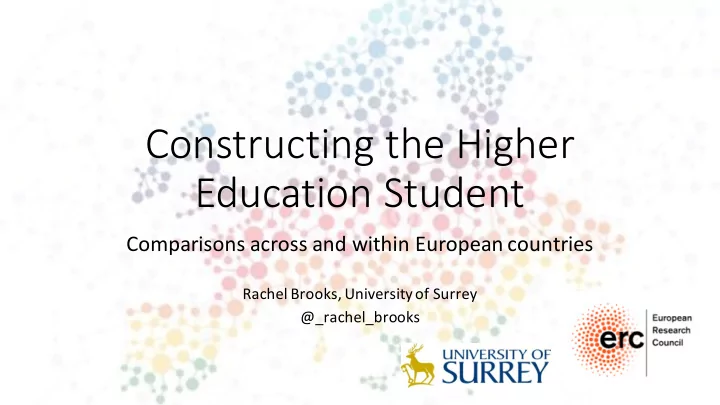

Constructing the Higher Education Student Comparisons across and within European countries Rachel Brooks, University of Surrey @_rachel_brooks
By studying abroad with Erasmus+, you can improve your communication, language and inter- cultural skills and gain soft skills highly valued by future employers. You can also combine your period spent studying abroad in a programme country with a traineeship to gain work experience - ever more important when starting out on the job market. (European Commission, 2016)
The European Higher Education Area (EHEA) is the result of the political will of 48 countries which, step by step during the last eighteen years, built an area using common tools. These 48 countries implement reforms on higher education on the basis of common key values – such as freedom of expression, autonomy for institutions, independent students unions, academic freedom, free movement of students and staff. Through this process, countries, institutions and stakeholders of the European area continuously adapt their higher education systems making them more compatible and strengthening their quality assurance mechanisms. (www.ehea.info, 2016)
Research questions How are understandings of the HE student produced, shaped & disseminated by (i) policymakers, (ii) the media and (iii) HE institutions? To what extent do these understandings differ within & across European nations? How do students of different national & social backgrounds understand the role of the HE student? To what extent are their understandings consonant with those produced, shaped & disseminated by policymakers, the media & HE institutions?
Six-nation comparative study Data collection in six European countries Denmark, England, Germany, Ireland, Poland & Spain Chosen to provide diversity in: Welfare regime Date of accession to European Union Level of tuition fees Nature of student support system
Four strands of data collection 1. Policy constructions Policy texts Interviews with policymakers 2. Media representations National newspapers Popular films or drama-based TV programmes 3. Institutional perspectives Institutional websites Interviews with staff members 4. Student understandings Focus groups
Constructions of students Consumers Workers Family members Political actors Degree of variation across and within European nations? Impact on identity as learners?
Students as consumers First emerged in US in 1970s Prevalence of consumer discourse differentiated by nation-state Differences among social actors in same country E.g. media – alternative constructions E.g. students – even in UK considerable variety (Tomlinson, 2016); different capacities to be ‘active choosers’ And differences by institution (less prevalent in high status universities)
Students as workers Paid work increasingly common across Europe More likely to be taken up by students with no family HE experience and/or who are older Considerable variation in: employment rates significance of ‘worker identity’ (e.g. Estonia) national discourses: investment in ‘workers-in-the-making’ Impact on academic progress and wider aspects of student life
Students as family members Increasing importance of family support – process of ‘Southern Europeanisation’ (Antonucci, 2016) Financial support & housing But enduring differences by welfare regime Also variation re dependent children E.g. Greece & Italy vs Norway & Sweden Impact on student identities (but likely to differ in relation to national norms)
Students as political actors Foregrounded only in 1960s In 21 st century, more political activity on part of students across Europe Shift in student representation But differences by nation In representation In responses to student politics And by social characteristics Impact of increased diversity?
Deconstructing the ‘European student’ Considerable diversity in way students live their lives Related to national policy and norms – processes of ‘recontextualisation’ Implications for ‘learner identities’ E.g. competing demands of paid work and family (relative to normative constructions) Difference by social characteristics Raises questions about assumed homogeneity within European policy But little research on students’ own understandings of role
To be continued….. www.eurostudents.net @eurostudents_
Recommend
More recommend